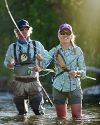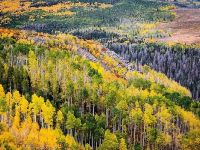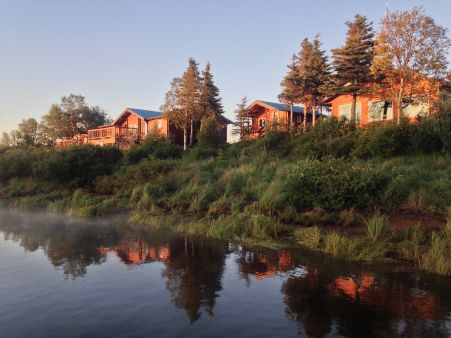“…for me, fly fishing is a great puzzle-solving challenge.”
– Jennifer Smith
The best anglers are always changing their tactics as conditions change from season to season, or even from moment to moment. This is perhaps the greatest draw of fly fishing and why so many become obsessed with the sport. Each day on the water provides a new challenge, a new puzzle to solve. This is what brings the angler back to familiar waters, or sends him or her lands away to seek new water. What will today’s challenge be?
SILVER CREEK
The warm weather has prolonged some late morning action with the few Tricos remaining along with some Baetis spinners. However, the best hatch activity has shifted to the Callibaetis in the afternoon. This bug is smaller than the early season Callibaetis, so y View more...“…for me, fly fishing is a great puzzle-solving challenge.”
– Jennifer Smith
The best anglers are always changing their tactics as conditions change from season to season, or even from moment to moment. This is perhaps the greatest draw of fly fishing and why so many become obsessed with the sport. Each day on the water provides a new challenge, a new puzzle to solve. This is what brings the angler back to familiar waters, or sends him or her lands away to seek new water. What will today’s challenge be?
SILVER CREEK
The warm weather has prolonged some late morning action with the few Tricos remaining along with some Baetis spinners. However, the best hatch activity has shifted to the Callibaetis in the afternoon. This bug is smaller than the early season Callibaetis, so you will need to have plenty of size 18s and 20s in all phases of this insects life cycle: nymphs, emergers, duns and spinners. To find Callibaetis, search the sloughs and slow water stretches of the upper and lower Kilpatrick’s Pond. The fly is easily identified by its rhythmic bouncing just above the water as it prepares to lay its eggs. On windy days, try a size 16 or 18 Hackle Stackers along with a Quigley Cripple or the Callibaetis Floating Nymph. When the water is still, try Harrop’s Partridge Spinner or Harrop’s Cutwing Dun in a size 18. Also watch the weather forecast over the next few weeks as cloudy, cool days will trigger fantastic Baetis hatches. These Baetis are small and you will need patterns in size 20, 22, and 24to match the hatch. For this bug, size is more important than color and fish should take any well presented fly. Also, be prepared for some Mahogany Duns as they will make an appearance in the coming weeks.
THE BIG WOOD
If you are looking for consistent action, then the Wood is the right choice. This river has been fishing incredibly well now that the flows have come down. Still, the Wood is on average 150 CFS higher than normal, so be prepared for strong currents. There is no need to go early, but once the fishing gets started mid-morning it stays good all the way until the sun leaves the water in the evening. This time of year the fish tend to spread out and can be found in every part of a run. Aggressive feeders will be right in the aerated heads of the riffles. Sippers can be found on the slow edges and in the seams as well as at the tail-outs and slicks. Approach the water carefully and scan the water for feeders in the shallows. These fish can be spooky and you will need to use caution. If the light is bad, try using small Gulper Specials (18) with orange posts which show up nicely in the glare and light chop of riffles. Also, Red Quills should appear in the South Valley and begin to make their way up river. Terrestrials have also been a good bet, especially hoppers and flying ants. Trailing a small size 16 or 18 Zebra Midge in red or black, a pheasant tail, Bishop’s Dynamite, or Rainbow Warrior can also be effective during slow periods.
WARM SPRINGS & TRAIL CREEK
For those seeking a good small stream experience, try Warm Springs or Trail Creek. There are plenty of stocked fish around the bridges and If you want to find some quality wild fish, just keep moving away from the easy road access. Expect to see hoppers, PMDs, and caddis throughout the day.
THE UPPER LOST
This is a good option if you like to fish in an area for its scenery and solitude. To be successful, you need to cover lots of water. Do this, and you will find some fine cutthroat trout and mountain whitefish in the deeper runs. Keep in mind, the trout will give you one chance, so make your first presentation count. Otherwise, be prepared to walk a long ways to the next fishy spot. For searching, try a Para Hopper, a flying ant, or an Elk Hair Caddis in size 14, 12 or 10 with a small trailing Zebra Midge, Bishop’s Dynamite, or Rainbow Warrior. If you find some feeders, use small size 18 parachute patterns, a long leader, and fine tippet.
THE LOST BELOW MACKAY
With flows just under 350 CFS, the wading is challenging in spots; however, the fishing has been good. Expect to find Trico and Baetis hatches mid-morning, but with the high flows, finding rising fish is a challenge. Nymphing remains the most effective method. Try standard dry dropper rigs or fish Euro Style techniques. The best patterns include Rubber Leg Stones, San Juan Worms, and King Princes in the heavy runs. For the shallow water, try small nymphs like Zebra Midge, Bishop’s Dynamite, Beaded Pheasant Tails, and Rainbow Warriors in size 16, 18, and 20 below an attractor dry of your choice. If you find rising fish, have a good selection of high vis Tricos and Baetis.
SALMON
The Salmon and its tributaries continues to fish well. Our guides are still drift boat fishing the upper and lower reaches of the river and the walk and wade fishing has been very good above Torrey’s Landing and through town. Try using bright colored attractor dries with orange and red, like Stimulators or Royal Wullfs, while searching the seams and riffles. Nymphing with a King Prince, a Bishop’s Dynamite, or Rubber Legged Stone is also very productive.
SOUTH FORK OF THE BOISE
The flows are holding steady at 600 CFS. While waiting for the bug activity to get started, try a hopper along the bank or skittering a crane fly across dancing water. A smattering of Flavs and Pink Alberts should appear in the early afternoon. Even a few beatis are beginning to make their midday appearance as well, especially on cloudy days. Your best option is to search the water with hoppers and a trailing nymph unless you find a fish feeding selectively on one of the above mentioned mayflies. Also, deep nymphing with caddis larva, PTs, and zebra midge can be a good option when no bugs present. Euro Nymping the shallower riffles has been very effective on whitefish and trout. You might try ripping a streamer through some deeper runs in search of a Bull Trout or an aggressive Bow.
LOCAL PONDS
Lake Creek, Penny Lake, or Gaver’s Lagoon have been stocked and will receive regular stockings throughout the summer season. Whatever style of fishing you want to do, we are your headquarters. So drop on by before you take your family fishing and we will make sure you have the right gear to be successful.
STREAM FLOWS
Silver Creek • 166 cfs
Big Wood • 329 cfs
South Fork of the Boise • 595 cfs
Big Lost • 338 cfs
Salmon • 709 cfs





